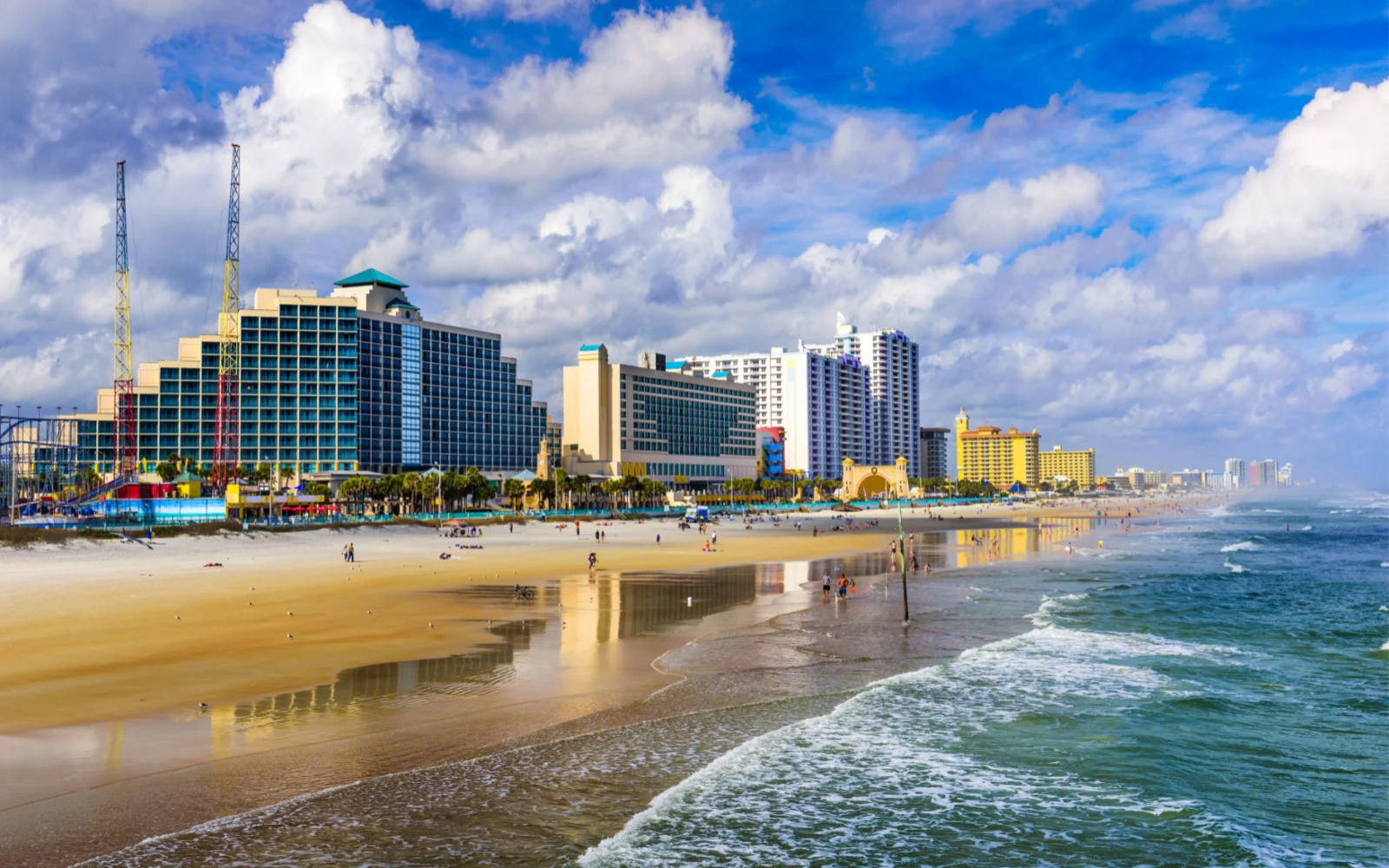Is Daytona Beach safe to visit?
Daytona Beach is generally safe for tourists, particularly in beachside areas and areas marketed to tourists. However, it does have a higher-than-average property theft and larceny rate, with 3,358 property crimes and 2,750 larceny crimes reported in 2018.
While the rate of violent crimes per 1,000 people is 3.068, mainly consisting of assaults, staying in well-lit, tourist-safe areas, avoiding South Daytona Beach and the Holly Hills area where the crime rate is higher, and being vigilant can help ensure a safe visit.
Daytona Beach in Florida is one of the most famous beaches in the world. Popular among tourists and race fans, Daytona Beach is well known for its hard-packed sand beaches, the racetrack made famous by the Daytona 500, and its vibrant and lively nightlife scene.
Daytona Beach sees over nine million visitors annually and is a popular vacation destination. Daytona Beach is a popular spring break location for students and draws a large crowd of motorcycle enthusiasts during its two annual motorcycle events — Bike Week and Biketober.
Additionally, Daytona Beach offers a wide variety of entertainment for all ages, from beautiful beaches and sunshine to live music on the boardwalk.
When planning a vacation to any city, the question of safety often comes up as a consideration. So, is Daytona Beach safe? Yes!
If you follow safe travel procedures and take some easy steps to protect yourself and your belongings, Daytona Beach is safe to visit either alone or in a group. Here are our top travel safety tips and considerations to keep in mind while visiting Daytona Beach, Florida.
Is Daytona Beach Safe to Visit in 2024?
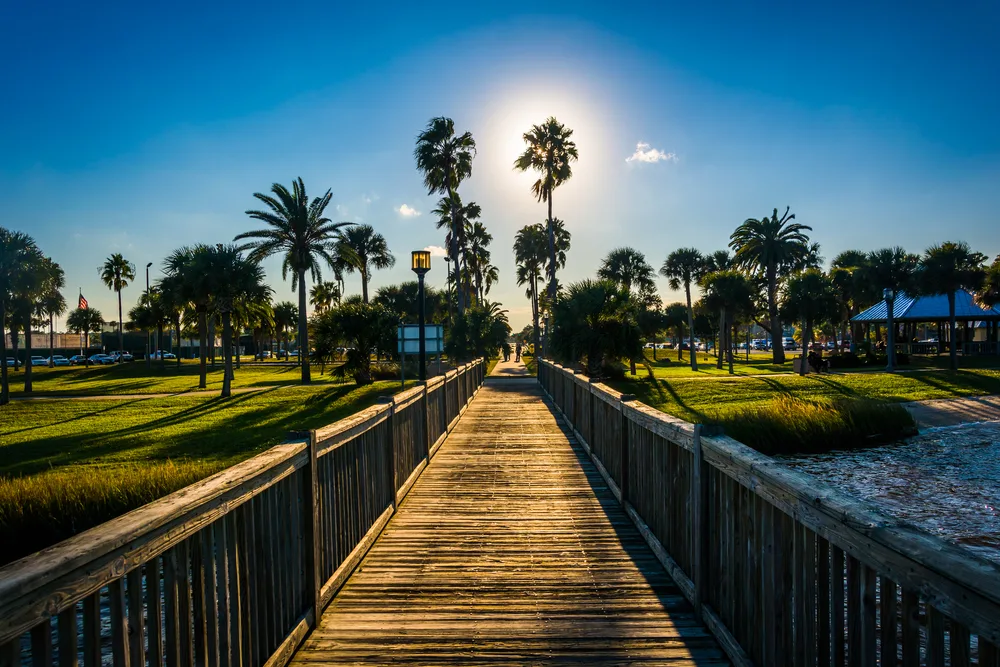
Jon Bilous/Shutterstock
Daytona Beach is safe to visit, especially the areas designed for and marketed to tourists.
While Daytona Beach does have a higher crime rate than other cities in Florida, research has shown that crime within Daytona Beach is localized in specific neighborhoods, predominantly in the mainland areas of Daytona Beach.
The beachside areas of Daytona Beach, where the vast majority of tourist attractions and the famously beautiful beaches are found, are generally considered safe for locals and tourists alike.
Crime in Daytona Beach
The most common crimes in Daytona Beach are property theft and larceny. In 2018, according to data from the FBI, Daytona Beach saw 3,358 property crimes and 2,750 counts of larceny crimes.
The breakdown of property theft and larceny crimes in Daytona Beach comes to 6.518 larceny crimes and 3.399 burglaries per 1,000 people.
How to Avoid Theft in Daytona Beach
Here are some tips to help protect your belongings while in Daytona Beach:
- Take steps to protect your belongings while out on the town. The most common crimes in Daytona Beach involve theft, so hide your valuables out of sight.
- Keep an eye on your belongings while at the beach or walking. Wear your purse or bag where you can see it, as this will help prevent opportunistic thieves from pick-pocketing when you aren’t looking.
- Stay aware of your surroundings.
- If you plan on biking, bring a bike lock and secure your bike when you’re not riding it.
- Stick to well-lit areas when walking at night
- Walk with a buddy when possible.
Daytona Beach does have a higher-than-average violent crime rate, with assaults making up the bulk of the violent crimes reported in Daytona Beach. The rate of violent crimes per 1,000 people in Daytona Beach is 3.068, with 1.969 incidents of assault annually.
How to Avoid Violent Crimes in Daytona Beach
Here are some safe travel practices to help keep you safe from violence crime while visiting Daytona Beach:
- Stay in areas that are considered safe for tourists. Ask at the hotel, resort, or campground for safe areas to explore if you’re unsure!
- Stick to well-lit, well-traveled streets.
- Avoid walking alone after dark.
- Keep an eye on your drink.
- Don’t take shortcuts.
- Be aware of your surroundings.
- Walk with a purpose, especially at night.
- Act confident.
Crime in Daytona Beach is worse in certain areas. In South Daytona Beach and the Holly Hills area, there is a 1 in 11 chance of becoming a victim of a crime.
Beachside and in North Daytona Beach, the chance falls to 1 in 76. Practicing good travel habits and avoiding rougher areas can help you have a safe vacation in Daytona Beach.
Avoiding Bad Neighborhoods in Daytona Beach

Andriy Blokhin/Shutterstock
The beachside areas of Daytona Beach are generally considered safe for tourists. Parts of mainland Daytona Beach are considered more dangerous and should be avoided or explored with caution during daylight hours.
The parts of Daytona Beach with the highest crime rates are the riverside areas. The riverside areas are the neighborhoods and districts found as you move away from the ocean and cross Atlantic Avenue towards the river.
Many of the neighborhoods in this area will appear quiet or deserted and are generally considered unsafe. Here are the parts of Daytona Beach to steer clear of and how to avoid them.
Holly Hills
Holly Hills, a neighborhood north of 3rd Street and the east of US-1, has a higher crime rate than other areas. While Holly Hills is not technically part of Daytona Beach, it is close enough to the metropolitan area to warrant a mention.
This suburb-style neighborhood lacks the tourist attractions and safety of Daytona Beach proper.
Williamson Boulevard
Found deep within mainland Daytona Beach, Williamson Boulevard is deep inland from the touristy areas of Daytona Beach, past the Security First Business Park. There isn’t much in the way of entertainment on Williamson Boulevard or in the surrounding areas.
Mason Avenue
Mason Avenue bisects Williamson Boulevard and runs all the way through to US-1. The areas surrounding the more inland side of Mason Avenue are largely industrial.
And the road itself leads away from beachside Daytona Beach and the entertainment found in the touristy areas and towards residential and industrial areas of Daytona Beach.
Safest Areas in Daytona Beach
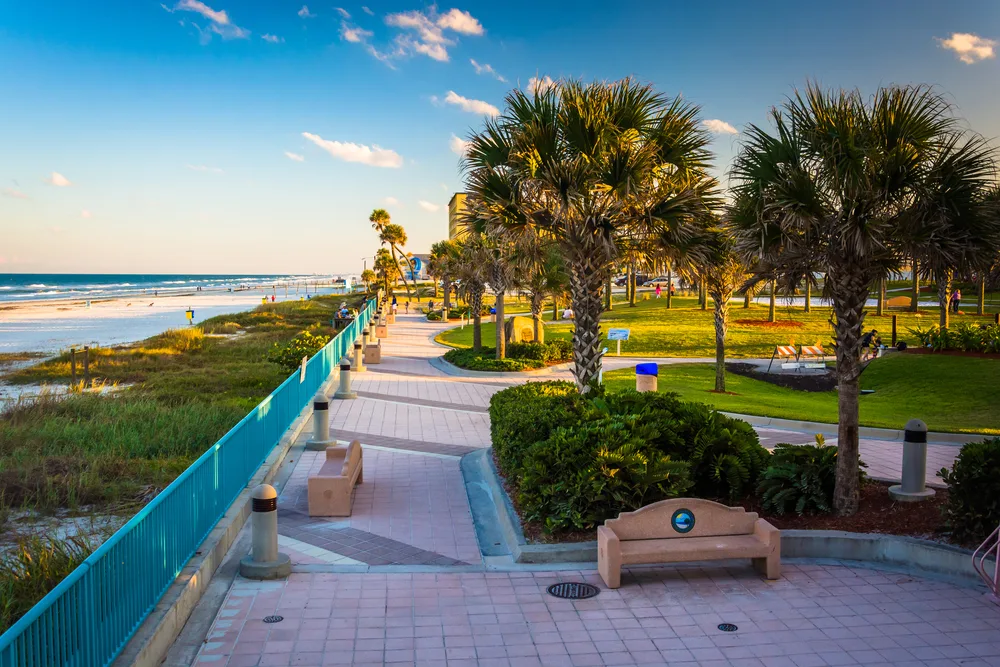
Jon Bilous/Shutterstock
Having looked at the more dangerous areas of Daytona Beach, here are some of the safest areas to explore and enjoy.
Daytona Beach Shores
Located in beachside Daytona Beach, the Daytona Beach Shores offer scores of entertainment for all ages. They offer park and facility rentals for large groups, and a variety of events that run almost every day.
From food trucks and markets to concerts, Daytona Beach Shores offers a range of events in addition to beaches staffed with lifeguards for swimming.
Boardwalk
Daytona Beach has a boardwalk. With great food and stunning views, the walk takes about twenty minutes and spans 1.8 km, or just over a mile. While you’re there, check out the Pier, a popular fishing spot!
The Daytona Beach Boardwalk is home to Ocean Walk Shoppes and an arcade, plus restaurants, snack shacks, and gift shops.
Every year from May through September, the Daytona Beach Bandshell Concerts are held on the Boardwalk and feature live music, street performers, and fireworks.
Screamer’s Park
Just south of the Boardwalk, Screamer’s Park is home to several sky-high attractions, including the Slingshot and the Vomatron. For visitors with an adventurous streak (and who are over 5”0 or 4”2 tall), Screamer’s Park is well worth checking out.
Defy gravity and experience weightlessness on the Slingshot, or feel like an astronaut on the Vomatron. As Screamer’s Park is located near the boardwalk and is a popular tourist attraction, it’s considered to be an incredibly safe area of Daytona Beach to explore.
In addition to the three locations mentioned above, anywhere along the beachside is generally considered to be both safe and tourist-friendly.
Things to Consider When Visiting Daytona Beach
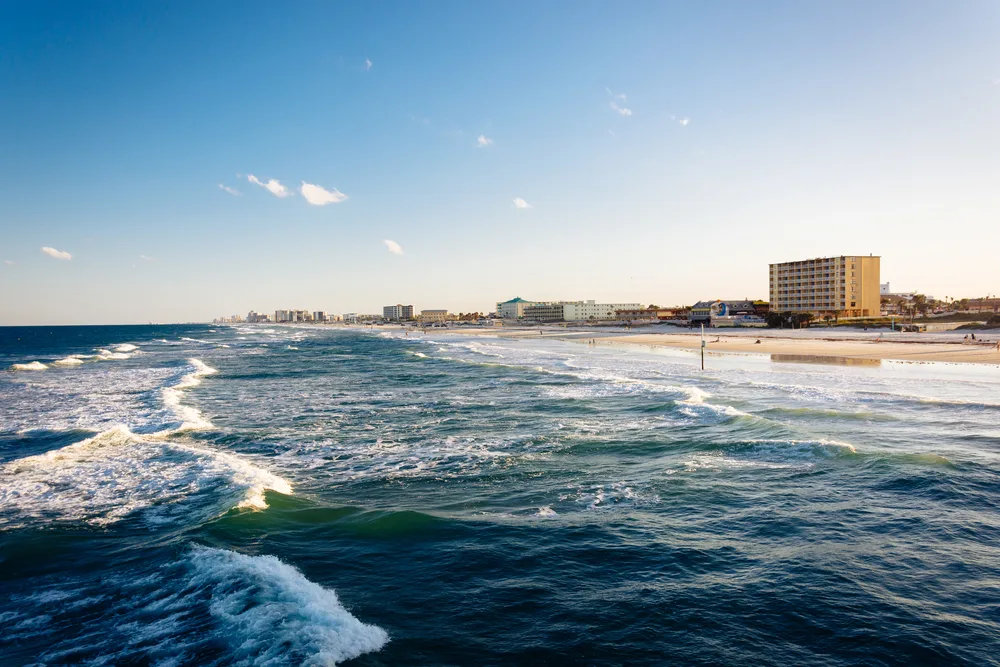
Jon Bilous/Shutterstock
If you’re planning a vacation to Daytona Beach, here are some things to consider!
Swimming Safety
Daytona Beach is known for its beautiful, hard-packed sandy beaches. The beaches are open for swimming year-round, as the water temperature remains above 68 degrees F even in the winter. If you’re planning on taking a swim in the balmy waters of Daytona Beach, there are a few things to be aware of.
Watch for riptides, and obey posted signage
Daytona Beach can experience rip currents, commonly referred to as riptides. Rip currents are powerful channels of fast-moving water that flow away from the shore and towards the open ocean.
These currents move incredibly quickly, at speeds of up to eight feet per second, and can be between 10 and 30 yards wide.
Lifeguards are trained to recognize these currents when they form and will post notices advising people to avoid swimming until the rip current disperses. Rip currents are an incredibly dangerous occurrence and can pull even the strongest swimmers out to sea.
Following all posted signage on the beach can help drastically reduce the chance of experiencing a rip current. If you get caught in a rip current, swim parallel to the shore until you exit the current, then swim into shore at an angle.
Share the ocean safely with sharks
While unprovoked shark bites are rare, Daytona Beach does see more shark bites than other areas in Florida. The Global Shark Attack File has documented 47 unprovoked bites in Daytona Beach and the surrounding area between 1947 and 2020.
When sharks bite humans, it’s most often due to the shark mistaking a person for a seal or turtle, their preferred diet. There are steps you can take to peacefully coexist with the sharks that make their home in the waters off the coast of Florida and avoid a case of mistaken identity.
Avoid swimming at dusk or dawn, when sharks are more active and visibility in the water is low. Swim with a group or around other swimmers, as sharks are more likely to mistake a single person for a tasty seal than a group of people.
Avoid swimming where people are fishing, or around schools of fish or other sea life. The Daytona Beach Pier is a popular fishing location, and the combination of fishing bait and fish fighting the line creates an ideal feeding location for sharks.
Schools of fish may also attract sharks. Finally, listen to any instructions given by lifeguards, as they will be able to inform swimmers before any close encounters occur!
Sun Safety
Daytona Beach sees an average of 230 sunny days each year. The ultra-violet, or UV, index ranges from an average of 4 in January to 7 during the summer months.
UV rays can be damaging to the skin and the eyes, and utilizing sun protection can prevent lasting damage or sunburn. Sunglasses and sunscreen are both recommended to protect yourself from the sun and UV rays.
When choosing sunglasses, look for pairs that offer 100% UV protection, as UV rays can damage your eyes. The CDC recommends choosing a broad-spectrum sunscreen with an SPF, or sun protection factor, of at least 15.
For best results, apply 30 minutes before entering the sun, and reapply every two hours. Sunscreen should be reapplied after swimming or drying off with a towel for the best protection.
Sunglasses and sunscreen are especially important if you’ll be spending time near the water, as water can reflect UV rays from the sun, increasing your exposure.
Frequently Asked Questions
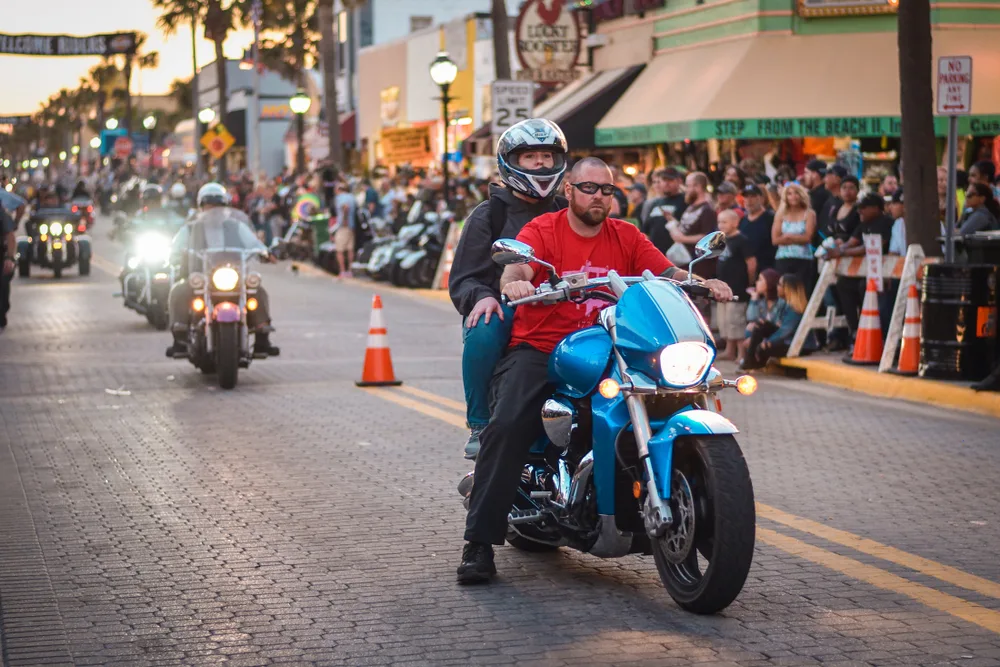
Daytona Beach Florida, USA, March 8th 2019: Daytona Bike Week/Perris Tumbao/Shutterstock
Planning a trip can leave you with questions. Here are the answers to some of the most frequently asked questions about Daytona Beach.
When Should I Avoid Daytona Beach?
Parents with young children are recommended to avoid visiting Daytona beach around Spring Break, Bike Week, and Biketober fest as these times may have higher levels of adults drinking and engaging in behavior that may be considered inappropriate for children.
Are there Sharks in Daytona Beach?
Yes, some sharks make their homes in the water off Daytona Beach. Lemon sharks, Black Nose sharks, Sandbar sharks, and Nurse sharks are some of the 15 species of sharks found off the coast of Florida.
Is Daytona Beach good for families?
Yes, Daytona Beach is good for families. Daytona Beach holds a waterpark, ocean swimming, adventure rides, and many other activities suitable for visitors of all ages.
Is Daytona Beach Good for Swimming?
Yes, Daytona Beach is good for swimming. The beach offers ADA-accessible facilities and multiple lifeguards on duty, making it a popular, pleasant, and safe place to swim.
So, Is Daytona Beach Safe to Visit?
Is Daytona Beach safe? For the most part, yes. Daytona Beach, one of the most famous beaches in America, is a popular tourist and vacation destination in Florida. When planning a vacation, the safety of yourself and your travel group is often one of the first considerations.
Daytona Beach is a safe place to visit and vacation as long as you follow safe travel practices. Reduce your chances of encountering crime by sticking to well-lit, tourist-friendly areas that are found on the beachside of Daytona Beach.
Avoid areas that are considered to be unsafe, such as neighborhoods within the industrial area and some of the riverside neighborhoods.
By taking steps to protect your belongings, obeying lifeguards and signage posted on the beach, and sticking to areas that are safe and recommended for tourists, you can help ensure that your trip to Daytona Beach is exciting and safe.
With warm water temperatures, sunny skies, and a multitude of activities, Daytona Beach offers something for all ages. Happy travels!



